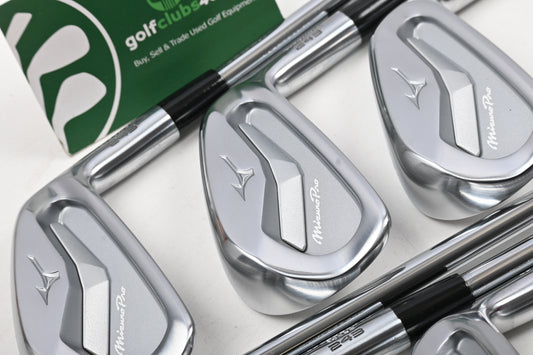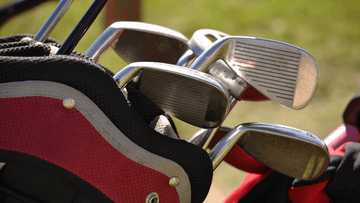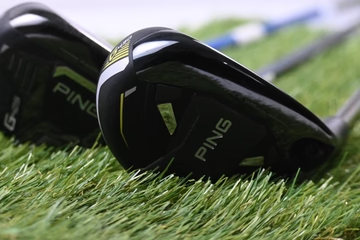Hybrid golf irons are a regular addition to most golfers’ bags, and that’s because they bring incredible versatility. They combine all the best features of a fairway wood and an iron, so make sure you leave room in your bag for one of these - you won’t regret it.


The complete guide to buying a second-hand golf iron
The good news is that the most expensive irons aren’t necessarily going to be the best choice for you, and the even better news is that when you buy second-hand golf irons you will be getting a whole lot more bang for your buck!
So read on to find out more about the factors to take into account when buying used golf iron sets. We’ll answer some of your burning questions and help you feel more confident in the iron set you choose. And if you still have questions, we’re on hand to help guide you through your options and help you find the perfect set of used golf irons for you - don’t hesitate to get in touch if you need a little extra help.
Irons - the basics
Let’s start by covering the basic information that you need to know when it comes to buying second-hand golf irons. Once your pre-loved driver has hit your ball off the tee, you’ll then rely heavily on your golf irons to take you closer to the hole. (Some players can even use an iron to hit the ball off the tee in certain scenarios). Because you have a range of irons to choose from, you’ll be able to use your irons for a variety of shots.
In any standard golf bag, you’ll find 14 golf clubs - that is the maximum number of clubs any one player is allowed (check out our post on the top three golf clubs to focus on). Of those 14 clubs, around 7-11 of them will be your irons - which also includes your wedges. Irons are sorted by a number from 1-10 but more commonly this is 3-9. This number indicates the (relative) angle of loft on the clubface, but they may also vary in terms of clubhead size, and length of the shaft.
Irons that have a higher loft than the numbered irons in your golf bag are also called wedges, pitching wedge (PW) and sand wedge (SW) - being the most common). But let’s not worry too much about wedges in this article, because you will find that most used golf iron sets contain at least one wedge.
So, when you’re looking at the description of an iron set online, it’ll say something along the lines of ‘3-PW’. This means that you will get a full set of irons starting from a ‘3’, and also a pitching wedge. Likewise, ‘5-SW’ means you will get a set starting from a ‘5’, going through to a sand wedge. You may also come across gap wedges (GW) and attack wedges (AW).
Golf irons are made - as the name would suggest - of metal. They have a large, flat and angled face, and they are usually scored with deeper grooves from toe to heel that help generate more ball spin and therefore control your shot better. They can be used in all sorts of different situations and are particularly handy for getting you out of a tight spot like a bunker or perhaps even shallow water. For better accuracy with close shots, golf iron club heads are thinner than some of the other clubs such as woods and hybrids.
Irons are, without a doubt, one of the most useful clubs for your game, so it’s important to get a set that is perfect for you. (Left-handed? We’ve got you covered with a huge range of left-handed used golf irons from all the leading brands).
Looking for a new Iron? Browse our latest stock


Mizuno Pro 243 Irons / 4-PW / Stiff Flex Dynamic Gold Mid 115 S300 Shafts


Mizuno JPX 925 Forged Irons / 5-PW / Regular Flex N.S. Pro Modus 3 Tour 105


Left Hand Cobra Air-X Irons / 5-PW+SW / Regular Flex Cobra Ultralite 50 Shafts


Left Hand Cobra Aerojet Irons / 5-PW+SW / Regular Flex KBS PGI 75 Shafts


Mizuno JPX 925 Hot Metal Irons / 5-PW / Regular Flex MMT 65 Shafts


Mizuno JPX 925 Hot Metal Irons / 5-PW / Stiff Flex KBS Tour Lite Shafts


Mizuno Pro 243 Irons / 4-PW / Stiff Flex Dynamic Gold 95 S300 Shafts


Mizuno JPX 925 Hot Metal Irons / 5-PW / Regular Flex KBS Tour Lite Shafts
When should I upgrade my iron?
If you’re an occasional player, perhaps getting out on the course up to a couple of times a week, then there’s no reason why a good quality set of golf irons shouldn’t last you from 5-10 years. But obviously, if you’re playing more regularly you might start to notice signs of wear and tear a little sooner than that.
When you buy used golf club irons from golfclubs4cash we can guarantee that they’re in tip-top shape using our condition guide, meaning you’ll be able to enjoy them for many years to come before you need to consider replacing them.
If your game is improving and you’d like to upgrade your clubs to a better spec, your existing golf clubs will still hold some value and you may be able to trade them in. As with all other types of clubs, things change and improvements are constantly being made. While traditional forged irons haven’t changed much in terms of specification in decades, the newer thin-faced irons tend to change every 3-5 years.
How much does a good used iron set cost?
The price of a used golf iron set varies quite a lot, depending on the spec and brand that you’re looking for. However, it’s possible to get a starter set of used irons for between £50 - £100. On the higher end of the range, professional irons sets can fetch over £1000 in some cases - but this is because they are of such high quality that they hold their value really well.
For amateurs, we would recommend that you budget at least £150 - £300 for a decent set of preloved golf irons. You’ll be able to choose from a wide range of clubs for that price and can always look at trading them in and upgrading them when you start to feel your game improving.
Choosing your iron set

Choosing your iron set
Choosing the perfect used golf iron set for you might take a little time and research, but it’s worth putting the effort in to find the right golf clubs that can help you take your game to the next level. Playing with sub-quality golf clubs will hamper your progress and this can often lead to players giving up on golf altogether.
If you’re really unsure, you can always seek the help of a PGA Pro who will be able to help you narrow down your options and point you towards a second-hand golf iron set that brings value for money according to your budget and matches your skill level. Make sure you’re clear on your budget before you start looking, and take time to compare brands and specifications.
Buying second hand golf irons is always a great idea - often they’ve barely been used and have a whole lot more life left in them meaning you’ll get far more for your money.
What material is a golf iron made from, and how are they made?
Golf irons are made of metal and are made in two different ways - they can either be forged irons or cast irons.
Advanced players tend to prefer forged golf irons, and they say that they offer a better feel - knowing instinctively when the ball has been hit off-centre. Because forging irons requires more time and skill, this is reflected in the price and they are always more expensive than cast irons.
Some irons have steel shafts while others have graphite shafts, and players often prefer one over the other when it comes to this. For example, a graphite shaft is generally lighter and able to absorb more vibration, so this could be a good choice of iron for someone suffering from arthritis.
A graphite shaft boasts a further distance than steel because it is lighter and gives faster swing speeds, but this is often reflected in the higher price. You can also find multi-material shafts, but these aren’t easy to come by.
Types of golf iron
There are two main types of golf iron, and at golfclubs4cash we stock a range of both. If you’re unsure which type of used golf club iron is best for you then we recommend you get in touch with our experts. They’ll be happy to advise you on the best type of golf iron for you - blade or cavity-backed.
The cavity back iron is a choice favoured by more inexperienced players with higher handicaps, mainly because of the benefits that the larger sweet spot can bring. As mentioned above, cavity-backed irons are even getting more popular with professional players now.
What about hybrid irons?
Irons all tend to have a medium loft (wedges have a higher loft and drivers have the minimum loft).
Shaft length
Deciding on the correct shaft length for you means knowing a bit about your posture such as how tall you are, and also the distance from your wrists to the floor! The standard ratio to use as a rule of thumb is that for every 6 inches of height you need a 1.5-inch difference between your irons. If you’re unsure, you can opt for a standard length of shaft and look to upgrade your iron shaft if you want to customise it.


Nippon N.S.PRO Zelos 7 #6 Iron Shaft / Regular Flex / 0.355" Tip / Uncut


True Temper XP 95 S300 Iron Shafts / Stiff Flex / Set Of 6 / .355" Tip


True Temper XP 95 #4 Iron / Regular Flex / 0.355" Tip / Uncut


True Temper XP 95 #7 Iron / Stiff Flex / 0.355" Tip / Uncut


True Temper XP 95 #5 Iron / Stiff Flex / 0.355" Tip / Uncut


Project X Precision Flighted #6 Iron Shaft / Stiff Flex / .355" Tip / Uncut


Nippon N.S.PRO Zelos 7 #3 Iron Shaft / Regular Flex / 0.355" Tip / Uncut


True Temper Elevate Tour Iron Shafts / Stiff Flex / Set Of 7 / .355 Taper Tip
Shaft flex
Next, you’ll need to choose the right shaft flex for you. This means the amount of bend that the club has. It’s easy enough to pick a shaft flex type such as ‘Ladies’, or ‘Senior’, but when you’re just starting out it may be difficult to know if you’d prefer ‘Regular’, ‘Stiff’ or ‘Extra Stiff’. The rule of thumb for shaft type is - the faster your swing speed, the stiffer you need your shaft to be. You may need to try out a variety of shaft types before you settle on the best type for you
Which irons do the top players love?

Which irons do the top players love?
According to PGA Club Tracker, the most popular irons used by professionals worldwide is currently Titleist, with the T100 coming out on top in 2022 and the 620MB coming close behind. PING and Callaway also feature heavily, as you would expect.
It’s hard to know what’s next for golf irons, but you can be sure that all the leading brands are constantly working on small modifications that will make big differences to your game. That said, the standard specifications and design of a standard golf iron haven’t changed much in decades, so whatever you buy you can be sure that it will serve you well for years to come without becoming outdated on the course.
What to do next?

What to do next?
Now you’ve learned a little more about finding the perfect used golf club for you, it’s a great idea to use our handy feature filter facility to narrow down your options. You’ll be able to choose between Men’s and Ladies’, left or right-handed, search by brand and by flex type and price. And you’re not limited to sets either - we stock an extensive range of individual used golf irons, too.
If you’ve narrowed it down to two or three options and you still can’t decide, give our friendly sales team a call. They’ll take you through a series of questions and advise on the perfect preloved golf club iron set for you. You may also find our FAQ section helpful.
Buying second hand clubs online with confidence
Buying second hand golf irons online is easy with golfclubs4cash. We offer worldwide delivery and a full returns policy, meaning you can buy all your used golf clubs online with 100% confidence. And because opting for a preloved golf club market means helping the planet too, you can shop safely in the knowledge that you’re helping to keep perfectly good clubs out of landfill.
And for the real bargain-hunters among you, keep an eye on our bargain basement, which is regularly updated with new items at a fraction of the price you’d pay for a new golf club.
All our second hand golf clubs are 100% authentic and genuine, and have had their condition appraised by an experienced golf club expert.
Local customers can visit our Edinburgh or Warrington golf store to try out our range and benefit from custom fits. Our pros are on hand whether in-person or by phone, and they’ll use their years of experience to help you find the perfect used fairway wood for you.
We’re proud to be Europe’s largest supplier of second hand golf clubs and equipment, and with over 24,000 clubs in stock at any given time, we’re the go-to online store for players of all abilities looking to find the best golf clubs at bargain prices.
Browse our extensive range of second hand golf fairways from the brands you love, and check out our 40,000+ 5* reviews on Trustpilot from happy customers!









